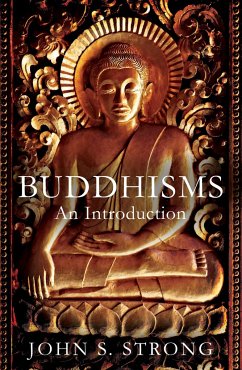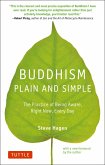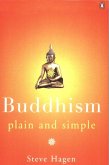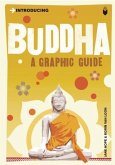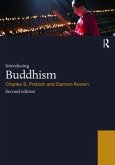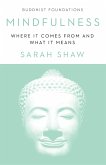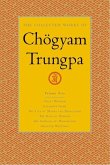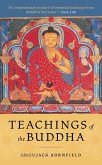- Broschiertes Buch
- Merkliste
- Auf die Merkliste
- Bewerten Bewerten
- Teilen
- Produkt teilen
- Produkterinnerung
- Produkterinnerung
A comprehensive survey of Buddhism as a religious tradition that is both coherent and diverse
Andere Kunden interessierten sich auch für
![Buddhism Plain and Simple Buddhism Plain and Simple]() Steve HagenBuddhism Plain and Simple17,99 €
Steve HagenBuddhism Plain and Simple17,99 €![Buddhism Plain and Simple Buddhism Plain and Simple]() Steve HagenBuddhism Plain and Simple18,99 €
Steve HagenBuddhism Plain and Simple18,99 €![Introducing Buddha Introducing Buddha]() Jane HopeIntroducing Buddha16,99 €
Jane HopeIntroducing Buddha16,99 €![Introducing Buddhism Introducing Buddhism]() Charles S. PrebishIntroducing Buddhism42,99 €
Charles S. PrebishIntroducing Buddhism42,99 €![Mindfulness Mindfulness]() Sarah ShawMindfulness24,99 €
Sarah ShawMindfulness24,99 €![The Collected Works of Chögyam Trungpa, Volume 5 The Collected Works of Chögyam Trungpa, Volume 5]() Chogyam TrungpaThe Collected Works of Chögyam Trungpa, Volume 543,99 €
Chogyam TrungpaThe Collected Works of Chögyam Trungpa, Volume 543,99 €![Teachings of the Buddha Teachings of the Buddha]() Jack KornfieldTeachings of the Buddha15,99 €
Jack KornfieldTeachings of the Buddha15,99 €-
-
-
A comprehensive survey of Buddhism as a religious tradition that is both coherent and diverse
Hinweis: Dieser Artikel kann nur an eine deutsche Lieferadresse ausgeliefert werden.
Hinweis: Dieser Artikel kann nur an eine deutsche Lieferadresse ausgeliefert werden.
Produktdetails
- Produktdetails
- Verlag: Oneworld Publications
- Seitenzahl: 480
- Erscheinungstermin: 1. August 2015
- Englisch
- Abmessung: 234mm x 156mm x 28mm
- Gewicht: 646g
- ISBN-13: 9781780745053
- ISBN-10: 1780745052
- Artikelnr.: 42055629
- Herstellerkennzeichnung
- Libri GmbH
- Europaallee 1
- 36244 Bad Hersfeld
- gpsr@libri.de
- Verlag: Oneworld Publications
- Seitenzahl: 480
- Erscheinungstermin: 1. August 2015
- Englisch
- Abmessung: 234mm x 156mm x 28mm
- Gewicht: 646g
- ISBN-13: 9781780745053
- ISBN-10: 1780745052
- Artikelnr.: 42055629
- Herstellerkennzeichnung
- Libri GmbH
- Europaallee 1
- 36244 Bad Hersfeld
- gpsr@libri.de
John S. Strong is Charles A. Dana Professor of Religious Studies at Bates College in Maine, USA. He is the author of four other books on Buddhism.
Preface
Schemes and Themes
Technicalities
Note on abbreviations
Chapter 1 Introduction: Lumbini, a Buddhist World Exposition
1.1 Theravada and Mahayana
1.2 Lumbini's Eastern Monastic Zone: South and Southeast Asian Traditions
1.2.1 The Maha Bodhi Society
1.2.2 The Sri Lanka Monastery
1.2.3 The Gautami Center for Nuns
1.2.4 Myanmar (Burma)
1.2.5 Meditation Centers
1.3 Lumbini's Western Monastic Zone: East Asian Traditions
1.3.1 China
1.3.2 Korea
1.3.3 Japan
1.3.4 Vietnam
1.4 Lumbini's Western Monastic Zone: Tibetan Vajrayana Traditions
1.4.1 The Great Lotus Stupa
1.4.2 The Lumbini Udyana Mahachaitya
Part I: Foundations of the Triple Gem: Buddha/s, Dharma/s, and Sa gha/s
Chapter 2 Sakyamuni, Lives and Legends
2.1 The Historical Buddha
2.2 The Buddha's World
2.3 The Buddha of Story
2.4 Past Buddhas and the Biographical Blueprint
2.5 The Start of Sakyamuni's Career
2.6 Previous Lives (Jatakas)
2.6.1 The Donkey in the Lion's Skin
2.6.2 Vessantara Jataka
2.6.3 The Tigress Jataka
2.7 A Lifestory of Sakyamuni
2.7.1 Birth and Childhood
2.7.2 Life in the Palace
2.7.3 The Beginnings of Discontent
2.7.4 The Great Departure
2.7.5 Paths Not Taken
2.7.6 Awakening
2.7.7 After Enlightenment
2.7.8 The First Sermon
2.7.9 Various Conversions and Miracles
2.7.10 Death and Parinirvana
Chapter 3 Overcoming the Buddha's Absence
3.1 Seeing the Buddha in the Dharma
3.1.1 Excursus on the Buddhist Canon/s
3.2 Places of Pilgrimage
3.3 Relics
3.4 Buddha Images
3.5 The Masters of the Dharma
3.6 The Arhat Dharma-Protectors
3.7 Meeting Maitreya
Chapter 4 Some Permutations of the Middle Way
4.1 The Middle Way
4.2 Karma and Sa sara
4.2.1 Why Do Good Deeds?
4.2.2 Contexts of Karma I: Neither Free Will nor Determinism
4.2.3 Contexts of Karma II: Both Jain and Upanisadic Views
4.3 The Doctrine of Non-Self (Anatman)
4.3.1 Breaking Down the False Sense of Self: the Five Aggregates and Impermanence
4.3.2 The Elements (Dharmas)
4.3.3 Countering the Breakdown of Self: Personal Continuity
4.3.4 Explications of Continuity: Pseudo-Selves and Ersatz Atmans
4.4 Summary
Chapter 5 The Four Truths
5.1 The First Truth: Stress
5.2 The Second Truth: the Continual Arising of Stress and Interdependent Origination
5.2.1 The Double Bind of Sa sara
5.3 The Third Truth: the Cessation of Stress - Nirvana
5.4 The Fourth Truth: the Path to the Cessation of Stress
5.4.1 Moral Discipline
5.4.2 Meditation
5.4.3 Wisdom
5.5 Other Systematizations of the Path
5.5.1 The Seven Factors Conducive to Enlightenment
5.5.2 The Graduated Training
5.5.3 The Four Divine Abidings
5.5.4 The Four Fruits of the Path
5.6 Summary
Chapter 6 The Establishment and Character of the Early Buddhist Community
6.1 Monastic-Lay Interactions
6.1.1 Dana (Giving) and Other Forms of Making Merit
6.1.2 Lay Ethics
6.1.3 Magical Protection
6.1.4 Laypersons and the Monastic Rules
6.1.5 Royal Supporters
6.1.6 King Asoka
6.2 The Monastics: Wandering and Settling
6.2.1 Monastic Lifestyles
6.2.2 Monasteries
6.3 Mahaprajapati and the Establishment of the Order of Nuns
6.4 Common Moral Commitments
6.5 Initiation Rituals: Wandering Forth and Ordination
6.6 Monastic Rules
6.6.1 The Elaboration of the Disciplinary Code
6.6.2 Enforcement of the Rules: Pratimoksa Recitation and Pravarana
6.7 Some Exemplary Disciples of the Buddha
6.7.1 Sariputra and Maudgalyayana
6.7.2 Pa acara
6.7.3 The Laypersons Nakulapitr and Nakulamatr
6.7.4 Visakha, Preeminent Laywoman
6.8 Summary
Chapter 7 Visions and Divisions of the Sa gha
7.1 Council Stories
7.1.1 The Council at Rajagrha
7.1.2 Vinaya Disputes: the Council of Vaisali
7.1.3 The Councils of Pa aliputra
7.1.4 Other Council Traditions
7.2 The Flowering of Mainstream Factionalism
7.3 Other Divisional Issues
7.3.1 Practice vs. Study
7.3.2 Meditators and Merit Makers
7.3.3 Forest Monks and Town Monks
7.3.4 The Question of Asceticism
7.3.5 The Question of Bon-Vivant Monks
7.3.6 Sect vs. Sect
7.4 The Origins of the Mahayana
7.5 Proliferation of Mahayana Schools
7.5.1 Mahayana Schools in India
7.5.2 Mahayana Schools in China
7.5.3 Mahayana Schools in Japan
7.5.4 Mahayana Schools in Tibet
7.6 Summary
Part II: Further Elaborations of the Triple Gem
Chapter 8 Mahayana and Vajrayana Ways of Meeting the Buddha/s
8.1 Changes in the View of the Buddha: the Lotus Sutra and Sakyamuni's Lifespan
8.2 Three Bodies of the Buddha/s
8.3 Meeting the Buddha/s in Their Pure Lands
8.3.1 Aksobhya
8.3.2 Bhaisajyaguru
8.4 Amitabha
8.4.1 Meeting Amitabha through Visualization
8.4.2 Rebirth in the Pure Land
8.5 Meeting the Buddha in the Great Bodhisattvas
8.5.1 Avalokitesvara
8.5.2 Other Great Bodhisattvas
8.6 Meeting the Buddha/s in the Vajrayana
8.6.1 Mandalas and the Five Tathagatas
8.6.2 Ritual Consecration (Abhiseka)
8.6.3 Merging with the Buddha
8.6.4 Visions: Meeting the Buddha/s in Bardo
8.6.5 Buddha Embodiments in This World: Gurus and Tülkus
8.7 Summary
Chapter 9 Mahayana Doctrinal Developments
9.1 Emptiness: the Selflessness of Dharmas
9.2 Nagarjuna and the Madhyamaka
9.3 The Expansion of Provisional Truth: Expedient Means (Upaya)
9.4 Tiantai Doctrines
9.5 The Ongoing Dialectic: the Yogacara School
9.5.1 Asanga and Vasubandhu and the Development of the School
9.5.2 Yogacara Doctrines
9.6 Avata saka Doctrines
9.6.1 Applications of Interpenetration
9.7 The Buddha Womb/Embryo (Tathagatagarbha) Teachings
9.7.1 Resurgence of the True Self
9.8 Buddha-Nature Controversies
9.8.1 Limitations to the Buddha-Nature: the Icchantika Debate
9.8.2 The End of the Dharma
9.8.3 Expansions of the Buddha-Nature Doctrine
9.9 Summary
Chapter 10 The Bodhisattva Path, Tantra, and Zen
10.1 The Bodhisattva Path
10.2 Sudden and Gradual
10.2.1 Disagreements over the Nature of the Path: the Debate at Samyé
10.2.2 Disagreements over the Nature of Enlightenment
10.3 Graduated Paths
10.3.1 Compassion and Bodhicitta
10.3.2 The Stages of the Path, the Perfections, the Five Paths
10.3.3 Routinization and Ritualization
10.4 Path Shortcuts
10.5 Tantra
10.5.1 Uniting the Poles
10.5.2 Tantric Physiology
10.5.3 Mahamudra and Dzokchen (Rdzogs chen)
10.6 Direct Experiences: Chan/Zen
10.6.1 K ans
10.6.2 Critical Phrases (Huatou)
10.7 Summary
Chapter 11 Sa gha Situations: Places, Persons, and Practices in Thai Buddhism/s
11.1 Buddhism in Thailand
11.2 Thai Monastic Life: Temporary Ordination
11.2.1 Life as a Novice
11.2.2 Experiences as a Monk
11.3 The Lives of Two Charismatic Thai Monks
11.3.1 Acharn Mun
11.3.2 Khruba Siwichai
11.4 The End of the Rains-Retreat in a Northern Thai Village
11.5 A Thai Temple in Wimbledon, England
Chapter 12 Sa gha Situations: Places, Persons, and Practices in Japanese Buddhism/s
12.1 The Hexagonal Hall (Rokkakud )
12.1.1 Prince Sh toku
12.1.2 Shinran
12.1.3 Kannon, Jiz , and Fud
12.2 The Ritual Year at Shinnyod
12.2.1 New Year's
12.2.2 akini and the Recitation of the Great Perfection of Wisdom Sutra
12.2.3 Main Hall Rituals
12.2.4 Goma
12.2.5 The Killing Stone
12.3 The Ry anji Rock Garden
12.4 The Buddha's Birthday at the Morgan Bay Zend
12.5 The Japan Temple in Lumbini
12.6 Conclusion
Chapter 13 Sa gha Situations: Places, Persons, and Practices in Tibetan Buddhism/s
13.1 Lhasa Jokhang
13.1.1 Pinning Down the Demoness
13.1.2 Flood Control
13.1.3 Grand Prostrations
10.1.4 The Great Prayer Festival
13.2 The Potala and the Dalai Lamas
13.2.1 Finding a New Dalai Lama
13.3 Scholars and Mad Saints
13.3.1 Drepung Monastery and Monastic Studies
13.3.2 Mad Monks: the Case of Tangtong Gyalpo
13.4 Samding: Female Incarnations and a Contemporary Buddhist
13.5 A Tibetan Dharma Center in Vermont, U.S.A.
13.6 Conclusion
Appendices
Appendix A: A Short Chronology of Buddhism in India
Appendix B: A Short Chronology of Buddhism in Sri Lanka
Appendix C: A Short Chronology of Buddhism in Myanmar (Burma)
Appendix D: A Short Chronology of Buddhism in Cambodia
Appendix E: A Short Chronology of Buddhism in Thailand
Appendix F: A Short Chronology of Buddhism in China
Appendix G: A Short Chronology of Buddhism in Japan
Appendix H: A Short Chronology of Buddhism in Vietnam
Appendix I: A Short Chronology of Buddhism in Tibet
Bibliography of Works Cited
Index
Schemes and Themes
Technicalities
Note on abbreviations
Chapter 1 Introduction: Lumbini, a Buddhist World Exposition
1.1 Theravada and Mahayana
1.2 Lumbini's Eastern Monastic Zone: South and Southeast Asian Traditions
1.2.1 The Maha Bodhi Society
1.2.2 The Sri Lanka Monastery
1.2.3 The Gautami Center for Nuns
1.2.4 Myanmar (Burma)
1.2.5 Meditation Centers
1.3 Lumbini's Western Monastic Zone: East Asian Traditions
1.3.1 China
1.3.2 Korea
1.3.3 Japan
1.3.4 Vietnam
1.4 Lumbini's Western Monastic Zone: Tibetan Vajrayana Traditions
1.4.1 The Great Lotus Stupa
1.4.2 The Lumbini Udyana Mahachaitya
Part I: Foundations of the Triple Gem: Buddha/s, Dharma/s, and Sa gha/s
Chapter 2 Sakyamuni, Lives and Legends
2.1 The Historical Buddha
2.2 The Buddha's World
2.3 The Buddha of Story
2.4 Past Buddhas and the Biographical Blueprint
2.5 The Start of Sakyamuni's Career
2.6 Previous Lives (Jatakas)
2.6.1 The Donkey in the Lion's Skin
2.6.2 Vessantara Jataka
2.6.3 The Tigress Jataka
2.7 A Lifestory of Sakyamuni
2.7.1 Birth and Childhood
2.7.2 Life in the Palace
2.7.3 The Beginnings of Discontent
2.7.4 The Great Departure
2.7.5 Paths Not Taken
2.7.6 Awakening
2.7.7 After Enlightenment
2.7.8 The First Sermon
2.7.9 Various Conversions and Miracles
2.7.10 Death and Parinirvana
Chapter 3 Overcoming the Buddha's Absence
3.1 Seeing the Buddha in the Dharma
3.1.1 Excursus on the Buddhist Canon/s
3.2 Places of Pilgrimage
3.3 Relics
3.4 Buddha Images
3.5 The Masters of the Dharma
3.6 The Arhat Dharma-Protectors
3.7 Meeting Maitreya
Chapter 4 Some Permutations of the Middle Way
4.1 The Middle Way
4.2 Karma and Sa sara
4.2.1 Why Do Good Deeds?
4.2.2 Contexts of Karma I: Neither Free Will nor Determinism
4.2.3 Contexts of Karma II: Both Jain and Upanisadic Views
4.3 The Doctrine of Non-Self (Anatman)
4.3.1 Breaking Down the False Sense of Self: the Five Aggregates and Impermanence
4.3.2 The Elements (Dharmas)
4.3.3 Countering the Breakdown of Self: Personal Continuity
4.3.4 Explications of Continuity: Pseudo-Selves and Ersatz Atmans
4.4 Summary
Chapter 5 The Four Truths
5.1 The First Truth: Stress
5.2 The Second Truth: the Continual Arising of Stress and Interdependent Origination
5.2.1 The Double Bind of Sa sara
5.3 The Third Truth: the Cessation of Stress - Nirvana
5.4 The Fourth Truth: the Path to the Cessation of Stress
5.4.1 Moral Discipline
5.4.2 Meditation
5.4.3 Wisdom
5.5 Other Systematizations of the Path
5.5.1 The Seven Factors Conducive to Enlightenment
5.5.2 The Graduated Training
5.5.3 The Four Divine Abidings
5.5.4 The Four Fruits of the Path
5.6 Summary
Chapter 6 The Establishment and Character of the Early Buddhist Community
6.1 Monastic-Lay Interactions
6.1.1 Dana (Giving) and Other Forms of Making Merit
6.1.2 Lay Ethics
6.1.3 Magical Protection
6.1.4 Laypersons and the Monastic Rules
6.1.5 Royal Supporters
6.1.6 King Asoka
6.2 The Monastics: Wandering and Settling
6.2.1 Monastic Lifestyles
6.2.2 Monasteries
6.3 Mahaprajapati and the Establishment of the Order of Nuns
6.4 Common Moral Commitments
6.5 Initiation Rituals: Wandering Forth and Ordination
6.6 Monastic Rules
6.6.1 The Elaboration of the Disciplinary Code
6.6.2 Enforcement of the Rules: Pratimoksa Recitation and Pravarana
6.7 Some Exemplary Disciples of the Buddha
6.7.1 Sariputra and Maudgalyayana
6.7.2 Pa acara
6.7.3 The Laypersons Nakulapitr and Nakulamatr
6.7.4 Visakha, Preeminent Laywoman
6.8 Summary
Chapter 7 Visions and Divisions of the Sa gha
7.1 Council Stories
7.1.1 The Council at Rajagrha
7.1.2 Vinaya Disputes: the Council of Vaisali
7.1.3 The Councils of Pa aliputra
7.1.4 Other Council Traditions
7.2 The Flowering of Mainstream Factionalism
7.3 Other Divisional Issues
7.3.1 Practice vs. Study
7.3.2 Meditators and Merit Makers
7.3.3 Forest Monks and Town Monks
7.3.4 The Question of Asceticism
7.3.5 The Question of Bon-Vivant Monks
7.3.6 Sect vs. Sect
7.4 The Origins of the Mahayana
7.5 Proliferation of Mahayana Schools
7.5.1 Mahayana Schools in India
7.5.2 Mahayana Schools in China
7.5.3 Mahayana Schools in Japan
7.5.4 Mahayana Schools in Tibet
7.6 Summary
Part II: Further Elaborations of the Triple Gem
Chapter 8 Mahayana and Vajrayana Ways of Meeting the Buddha/s
8.1 Changes in the View of the Buddha: the Lotus Sutra and Sakyamuni's Lifespan
8.2 Three Bodies of the Buddha/s
8.3 Meeting the Buddha/s in Their Pure Lands
8.3.1 Aksobhya
8.3.2 Bhaisajyaguru
8.4 Amitabha
8.4.1 Meeting Amitabha through Visualization
8.4.2 Rebirth in the Pure Land
8.5 Meeting the Buddha in the Great Bodhisattvas
8.5.1 Avalokitesvara
8.5.2 Other Great Bodhisattvas
8.6 Meeting the Buddha/s in the Vajrayana
8.6.1 Mandalas and the Five Tathagatas
8.6.2 Ritual Consecration (Abhiseka)
8.6.3 Merging with the Buddha
8.6.4 Visions: Meeting the Buddha/s in Bardo
8.6.5 Buddha Embodiments in This World: Gurus and Tülkus
8.7 Summary
Chapter 9 Mahayana Doctrinal Developments
9.1 Emptiness: the Selflessness of Dharmas
9.2 Nagarjuna and the Madhyamaka
9.3 The Expansion of Provisional Truth: Expedient Means (Upaya)
9.4 Tiantai Doctrines
9.5 The Ongoing Dialectic: the Yogacara School
9.5.1 Asanga and Vasubandhu and the Development of the School
9.5.2 Yogacara Doctrines
9.6 Avata saka Doctrines
9.6.1 Applications of Interpenetration
9.7 The Buddha Womb/Embryo (Tathagatagarbha) Teachings
9.7.1 Resurgence of the True Self
9.8 Buddha-Nature Controversies
9.8.1 Limitations to the Buddha-Nature: the Icchantika Debate
9.8.2 The End of the Dharma
9.8.3 Expansions of the Buddha-Nature Doctrine
9.9 Summary
Chapter 10 The Bodhisattva Path, Tantra, and Zen
10.1 The Bodhisattva Path
10.2 Sudden and Gradual
10.2.1 Disagreements over the Nature of the Path: the Debate at Samyé
10.2.2 Disagreements over the Nature of Enlightenment
10.3 Graduated Paths
10.3.1 Compassion and Bodhicitta
10.3.2 The Stages of the Path, the Perfections, the Five Paths
10.3.3 Routinization and Ritualization
10.4 Path Shortcuts
10.5 Tantra
10.5.1 Uniting the Poles
10.5.2 Tantric Physiology
10.5.3 Mahamudra and Dzokchen (Rdzogs chen)
10.6 Direct Experiences: Chan/Zen
10.6.1 K ans
10.6.2 Critical Phrases (Huatou)
10.7 Summary
Chapter 11 Sa gha Situations: Places, Persons, and Practices in Thai Buddhism/s
11.1 Buddhism in Thailand
11.2 Thai Monastic Life: Temporary Ordination
11.2.1 Life as a Novice
11.2.2 Experiences as a Monk
11.3 The Lives of Two Charismatic Thai Monks
11.3.1 Acharn Mun
11.3.2 Khruba Siwichai
11.4 The End of the Rains-Retreat in a Northern Thai Village
11.5 A Thai Temple in Wimbledon, England
Chapter 12 Sa gha Situations: Places, Persons, and Practices in Japanese Buddhism/s
12.1 The Hexagonal Hall (Rokkakud )
12.1.1 Prince Sh toku
12.1.2 Shinran
12.1.3 Kannon, Jiz , and Fud
12.2 The Ritual Year at Shinnyod
12.2.1 New Year's
12.2.2 akini and the Recitation of the Great Perfection of Wisdom Sutra
12.2.3 Main Hall Rituals
12.2.4 Goma
12.2.5 The Killing Stone
12.3 The Ry anji Rock Garden
12.4 The Buddha's Birthday at the Morgan Bay Zend
12.5 The Japan Temple in Lumbini
12.6 Conclusion
Chapter 13 Sa gha Situations: Places, Persons, and Practices in Tibetan Buddhism/s
13.1 Lhasa Jokhang
13.1.1 Pinning Down the Demoness
13.1.2 Flood Control
13.1.3 Grand Prostrations
10.1.4 The Great Prayer Festival
13.2 The Potala and the Dalai Lamas
13.2.1 Finding a New Dalai Lama
13.3 Scholars and Mad Saints
13.3.1 Drepung Monastery and Monastic Studies
13.3.2 Mad Monks: the Case of Tangtong Gyalpo
13.4 Samding: Female Incarnations and a Contemporary Buddhist
13.5 A Tibetan Dharma Center in Vermont, U.S.A.
13.6 Conclusion
Appendices
Appendix A: A Short Chronology of Buddhism in India
Appendix B: A Short Chronology of Buddhism in Sri Lanka
Appendix C: A Short Chronology of Buddhism in Myanmar (Burma)
Appendix D: A Short Chronology of Buddhism in Cambodia
Appendix E: A Short Chronology of Buddhism in Thailand
Appendix F: A Short Chronology of Buddhism in China
Appendix G: A Short Chronology of Buddhism in Japan
Appendix H: A Short Chronology of Buddhism in Vietnam
Appendix I: A Short Chronology of Buddhism in Tibet
Bibliography of Works Cited
Index
Preface
Schemes and Themes
Technicalities
Note on abbreviations
Chapter 1 Introduction: Lumbini, a Buddhist World Exposition
1.1 Theravada and Mahayana
1.2 Lumbini's Eastern Monastic Zone: South and Southeast Asian Traditions
1.2.1 The Maha Bodhi Society
1.2.2 The Sri Lanka Monastery
1.2.3 The Gautami Center for Nuns
1.2.4 Myanmar (Burma)
1.2.5 Meditation Centers
1.3 Lumbini's Western Monastic Zone: East Asian Traditions
1.3.1 China
1.3.2 Korea
1.3.3 Japan
1.3.4 Vietnam
1.4 Lumbini's Western Monastic Zone: Tibetan Vajrayana Traditions
1.4.1 The Great Lotus Stupa
1.4.2 The Lumbini Udyana Mahachaitya
Part I: Foundations of the Triple Gem: Buddha/s, Dharma/s, and Sa gha/s
Chapter 2 Sakyamuni, Lives and Legends
2.1 The Historical Buddha
2.2 The Buddha's World
2.3 The Buddha of Story
2.4 Past Buddhas and the Biographical Blueprint
2.5 The Start of Sakyamuni's Career
2.6 Previous Lives (Jatakas)
2.6.1 The Donkey in the Lion's Skin
2.6.2 Vessantara Jataka
2.6.3 The Tigress Jataka
2.7 A Lifestory of Sakyamuni
2.7.1 Birth and Childhood
2.7.2 Life in the Palace
2.7.3 The Beginnings of Discontent
2.7.4 The Great Departure
2.7.5 Paths Not Taken
2.7.6 Awakening
2.7.7 After Enlightenment
2.7.8 The First Sermon
2.7.9 Various Conversions and Miracles
2.7.10 Death and Parinirvana
Chapter 3 Overcoming the Buddha's Absence
3.1 Seeing the Buddha in the Dharma
3.1.1 Excursus on the Buddhist Canon/s
3.2 Places of Pilgrimage
3.3 Relics
3.4 Buddha Images
3.5 The Masters of the Dharma
3.6 The Arhat Dharma-Protectors
3.7 Meeting Maitreya
Chapter 4 Some Permutations of the Middle Way
4.1 The Middle Way
4.2 Karma and Sa sara
4.2.1 Why Do Good Deeds?
4.2.2 Contexts of Karma I: Neither Free Will nor Determinism
4.2.3 Contexts of Karma II: Both Jain and Upanisadic Views
4.3 The Doctrine of Non-Self (Anatman)
4.3.1 Breaking Down the False Sense of Self: the Five Aggregates and Impermanence
4.3.2 The Elements (Dharmas)
4.3.3 Countering the Breakdown of Self: Personal Continuity
4.3.4 Explications of Continuity: Pseudo-Selves and Ersatz Atmans
4.4 Summary
Chapter 5 The Four Truths
5.1 The First Truth: Stress
5.2 The Second Truth: the Continual Arising of Stress and Interdependent Origination
5.2.1 The Double Bind of Sa sara
5.3 The Third Truth: the Cessation of Stress - Nirvana
5.4 The Fourth Truth: the Path to the Cessation of Stress
5.4.1 Moral Discipline
5.4.2 Meditation
5.4.3 Wisdom
5.5 Other Systematizations of the Path
5.5.1 The Seven Factors Conducive to Enlightenment
5.5.2 The Graduated Training
5.5.3 The Four Divine Abidings
5.5.4 The Four Fruits of the Path
5.6 Summary
Chapter 6 The Establishment and Character of the Early Buddhist Community
6.1 Monastic-Lay Interactions
6.1.1 Dana (Giving) and Other Forms of Making Merit
6.1.2 Lay Ethics
6.1.3 Magical Protection
6.1.4 Laypersons and the Monastic Rules
6.1.5 Royal Supporters
6.1.6 King Asoka
6.2 The Monastics: Wandering and Settling
6.2.1 Monastic Lifestyles
6.2.2 Monasteries
6.3 Mahaprajapati and the Establishment of the Order of Nuns
6.4 Common Moral Commitments
6.5 Initiation Rituals: Wandering Forth and Ordination
6.6 Monastic Rules
6.6.1 The Elaboration of the Disciplinary Code
6.6.2 Enforcement of the Rules: Pratimoksa Recitation and Pravarana
6.7 Some Exemplary Disciples of the Buddha
6.7.1 Sariputra and Maudgalyayana
6.7.2 Pa acara
6.7.3 The Laypersons Nakulapitr and Nakulamatr
6.7.4 Visakha, Preeminent Laywoman
6.8 Summary
Chapter 7 Visions and Divisions of the Sa gha
7.1 Council Stories
7.1.1 The Council at Rajagrha
7.1.2 Vinaya Disputes: the Council of Vaisali
7.1.3 The Councils of Pa aliputra
7.1.4 Other Council Traditions
7.2 The Flowering of Mainstream Factionalism
7.3 Other Divisional Issues
7.3.1 Practice vs. Study
7.3.2 Meditators and Merit Makers
7.3.3 Forest Monks and Town Monks
7.3.4 The Question of Asceticism
7.3.5 The Question of Bon-Vivant Monks
7.3.6 Sect vs. Sect
7.4 The Origins of the Mahayana
7.5 Proliferation of Mahayana Schools
7.5.1 Mahayana Schools in India
7.5.2 Mahayana Schools in China
7.5.3 Mahayana Schools in Japan
7.5.4 Mahayana Schools in Tibet
7.6 Summary
Part II: Further Elaborations of the Triple Gem
Chapter 8 Mahayana and Vajrayana Ways of Meeting the Buddha/s
8.1 Changes in the View of the Buddha: the Lotus Sutra and Sakyamuni's Lifespan
8.2 Three Bodies of the Buddha/s
8.3 Meeting the Buddha/s in Their Pure Lands
8.3.1 Aksobhya
8.3.2 Bhaisajyaguru
8.4 Amitabha
8.4.1 Meeting Amitabha through Visualization
8.4.2 Rebirth in the Pure Land
8.5 Meeting the Buddha in the Great Bodhisattvas
8.5.1 Avalokitesvara
8.5.2 Other Great Bodhisattvas
8.6 Meeting the Buddha/s in the Vajrayana
8.6.1 Mandalas and the Five Tathagatas
8.6.2 Ritual Consecration (Abhiseka)
8.6.3 Merging with the Buddha
8.6.4 Visions: Meeting the Buddha/s in Bardo
8.6.5 Buddha Embodiments in This World: Gurus and Tülkus
8.7 Summary
Chapter 9 Mahayana Doctrinal Developments
9.1 Emptiness: the Selflessness of Dharmas
9.2 Nagarjuna and the Madhyamaka
9.3 The Expansion of Provisional Truth: Expedient Means (Upaya)
9.4 Tiantai Doctrines
9.5 The Ongoing Dialectic: the Yogacara School
9.5.1 Asanga and Vasubandhu and the Development of the School
9.5.2 Yogacara Doctrines
9.6 Avata saka Doctrines
9.6.1 Applications of Interpenetration
9.7 The Buddha Womb/Embryo (Tathagatagarbha) Teachings
9.7.1 Resurgence of the True Self
9.8 Buddha-Nature Controversies
9.8.1 Limitations to the Buddha-Nature: the Icchantika Debate
9.8.2 The End of the Dharma
9.8.3 Expansions of the Buddha-Nature Doctrine
9.9 Summary
Chapter 10 The Bodhisattva Path, Tantra, and Zen
10.1 The Bodhisattva Path
10.2 Sudden and Gradual
10.2.1 Disagreements over the Nature of the Path: the Debate at Samyé
10.2.2 Disagreements over the Nature of Enlightenment
10.3 Graduated Paths
10.3.1 Compassion and Bodhicitta
10.3.2 The Stages of the Path, the Perfections, the Five Paths
10.3.3 Routinization and Ritualization
10.4 Path Shortcuts
10.5 Tantra
10.5.1 Uniting the Poles
10.5.2 Tantric Physiology
10.5.3 Mahamudra and Dzokchen (Rdzogs chen)
10.6 Direct Experiences: Chan/Zen
10.6.1 K ans
10.6.2 Critical Phrases (Huatou)
10.7 Summary
Chapter 11 Sa gha Situations: Places, Persons, and Practices in Thai Buddhism/s
11.1 Buddhism in Thailand
11.2 Thai Monastic Life: Temporary Ordination
11.2.1 Life as a Novice
11.2.2 Experiences as a Monk
11.3 The Lives of Two Charismatic Thai Monks
11.3.1 Acharn Mun
11.3.2 Khruba Siwichai
11.4 The End of the Rains-Retreat in a Northern Thai Village
11.5 A Thai Temple in Wimbledon, England
Chapter 12 Sa gha Situations: Places, Persons, and Practices in Japanese Buddhism/s
12.1 The Hexagonal Hall (Rokkakud )
12.1.1 Prince Sh toku
12.1.2 Shinran
12.1.3 Kannon, Jiz , and Fud
12.2 The Ritual Year at Shinnyod
12.2.1 New Year's
12.2.2 akini and the Recitation of the Great Perfection of Wisdom Sutra
12.2.3 Main Hall Rituals
12.2.4 Goma
12.2.5 The Killing Stone
12.3 The Ry anji Rock Garden
12.4 The Buddha's Birthday at the Morgan Bay Zend
12.5 The Japan Temple in Lumbini
12.6 Conclusion
Chapter 13 Sa gha Situations: Places, Persons, and Practices in Tibetan Buddhism/s
13.1 Lhasa Jokhang
13.1.1 Pinning Down the Demoness
13.1.2 Flood Control
13.1.3 Grand Prostrations
10.1.4 The Great Prayer Festival
13.2 The Potala and the Dalai Lamas
13.2.1 Finding a New Dalai Lama
13.3 Scholars and Mad Saints
13.3.1 Drepung Monastery and Monastic Studies
13.3.2 Mad Monks: the Case of Tangtong Gyalpo
13.4 Samding: Female Incarnations and a Contemporary Buddhist
13.5 A Tibetan Dharma Center in Vermont, U.S.A.
13.6 Conclusion
Appendices
Appendix A: A Short Chronology of Buddhism in India
Appendix B: A Short Chronology of Buddhism in Sri Lanka
Appendix C: A Short Chronology of Buddhism in Myanmar (Burma)
Appendix D: A Short Chronology of Buddhism in Cambodia
Appendix E: A Short Chronology of Buddhism in Thailand
Appendix F: A Short Chronology of Buddhism in China
Appendix G: A Short Chronology of Buddhism in Japan
Appendix H: A Short Chronology of Buddhism in Vietnam
Appendix I: A Short Chronology of Buddhism in Tibet
Bibliography of Works Cited
Index
Schemes and Themes
Technicalities
Note on abbreviations
Chapter 1 Introduction: Lumbini, a Buddhist World Exposition
1.1 Theravada and Mahayana
1.2 Lumbini's Eastern Monastic Zone: South and Southeast Asian Traditions
1.2.1 The Maha Bodhi Society
1.2.2 The Sri Lanka Monastery
1.2.3 The Gautami Center for Nuns
1.2.4 Myanmar (Burma)
1.2.5 Meditation Centers
1.3 Lumbini's Western Monastic Zone: East Asian Traditions
1.3.1 China
1.3.2 Korea
1.3.3 Japan
1.3.4 Vietnam
1.4 Lumbini's Western Monastic Zone: Tibetan Vajrayana Traditions
1.4.1 The Great Lotus Stupa
1.4.2 The Lumbini Udyana Mahachaitya
Part I: Foundations of the Triple Gem: Buddha/s, Dharma/s, and Sa gha/s
Chapter 2 Sakyamuni, Lives and Legends
2.1 The Historical Buddha
2.2 The Buddha's World
2.3 The Buddha of Story
2.4 Past Buddhas and the Biographical Blueprint
2.5 The Start of Sakyamuni's Career
2.6 Previous Lives (Jatakas)
2.6.1 The Donkey in the Lion's Skin
2.6.2 Vessantara Jataka
2.6.3 The Tigress Jataka
2.7 A Lifestory of Sakyamuni
2.7.1 Birth and Childhood
2.7.2 Life in the Palace
2.7.3 The Beginnings of Discontent
2.7.4 The Great Departure
2.7.5 Paths Not Taken
2.7.6 Awakening
2.7.7 After Enlightenment
2.7.8 The First Sermon
2.7.9 Various Conversions and Miracles
2.7.10 Death and Parinirvana
Chapter 3 Overcoming the Buddha's Absence
3.1 Seeing the Buddha in the Dharma
3.1.1 Excursus on the Buddhist Canon/s
3.2 Places of Pilgrimage
3.3 Relics
3.4 Buddha Images
3.5 The Masters of the Dharma
3.6 The Arhat Dharma-Protectors
3.7 Meeting Maitreya
Chapter 4 Some Permutations of the Middle Way
4.1 The Middle Way
4.2 Karma and Sa sara
4.2.1 Why Do Good Deeds?
4.2.2 Contexts of Karma I: Neither Free Will nor Determinism
4.2.3 Contexts of Karma II: Both Jain and Upanisadic Views
4.3 The Doctrine of Non-Self (Anatman)
4.3.1 Breaking Down the False Sense of Self: the Five Aggregates and Impermanence
4.3.2 The Elements (Dharmas)
4.3.3 Countering the Breakdown of Self: Personal Continuity
4.3.4 Explications of Continuity: Pseudo-Selves and Ersatz Atmans
4.4 Summary
Chapter 5 The Four Truths
5.1 The First Truth: Stress
5.2 The Second Truth: the Continual Arising of Stress and Interdependent Origination
5.2.1 The Double Bind of Sa sara
5.3 The Third Truth: the Cessation of Stress - Nirvana
5.4 The Fourth Truth: the Path to the Cessation of Stress
5.4.1 Moral Discipline
5.4.2 Meditation
5.4.3 Wisdom
5.5 Other Systematizations of the Path
5.5.1 The Seven Factors Conducive to Enlightenment
5.5.2 The Graduated Training
5.5.3 The Four Divine Abidings
5.5.4 The Four Fruits of the Path
5.6 Summary
Chapter 6 The Establishment and Character of the Early Buddhist Community
6.1 Monastic-Lay Interactions
6.1.1 Dana (Giving) and Other Forms of Making Merit
6.1.2 Lay Ethics
6.1.3 Magical Protection
6.1.4 Laypersons and the Monastic Rules
6.1.5 Royal Supporters
6.1.6 King Asoka
6.2 The Monastics: Wandering and Settling
6.2.1 Monastic Lifestyles
6.2.2 Monasteries
6.3 Mahaprajapati and the Establishment of the Order of Nuns
6.4 Common Moral Commitments
6.5 Initiation Rituals: Wandering Forth and Ordination
6.6 Monastic Rules
6.6.1 The Elaboration of the Disciplinary Code
6.6.2 Enforcement of the Rules: Pratimoksa Recitation and Pravarana
6.7 Some Exemplary Disciples of the Buddha
6.7.1 Sariputra and Maudgalyayana
6.7.2 Pa acara
6.7.3 The Laypersons Nakulapitr and Nakulamatr
6.7.4 Visakha, Preeminent Laywoman
6.8 Summary
Chapter 7 Visions and Divisions of the Sa gha
7.1 Council Stories
7.1.1 The Council at Rajagrha
7.1.2 Vinaya Disputes: the Council of Vaisali
7.1.3 The Councils of Pa aliputra
7.1.4 Other Council Traditions
7.2 The Flowering of Mainstream Factionalism
7.3 Other Divisional Issues
7.3.1 Practice vs. Study
7.3.2 Meditators and Merit Makers
7.3.3 Forest Monks and Town Monks
7.3.4 The Question of Asceticism
7.3.5 The Question of Bon-Vivant Monks
7.3.6 Sect vs. Sect
7.4 The Origins of the Mahayana
7.5 Proliferation of Mahayana Schools
7.5.1 Mahayana Schools in India
7.5.2 Mahayana Schools in China
7.5.3 Mahayana Schools in Japan
7.5.4 Mahayana Schools in Tibet
7.6 Summary
Part II: Further Elaborations of the Triple Gem
Chapter 8 Mahayana and Vajrayana Ways of Meeting the Buddha/s
8.1 Changes in the View of the Buddha: the Lotus Sutra and Sakyamuni's Lifespan
8.2 Three Bodies of the Buddha/s
8.3 Meeting the Buddha/s in Their Pure Lands
8.3.1 Aksobhya
8.3.2 Bhaisajyaguru
8.4 Amitabha
8.4.1 Meeting Amitabha through Visualization
8.4.2 Rebirth in the Pure Land
8.5 Meeting the Buddha in the Great Bodhisattvas
8.5.1 Avalokitesvara
8.5.2 Other Great Bodhisattvas
8.6 Meeting the Buddha/s in the Vajrayana
8.6.1 Mandalas and the Five Tathagatas
8.6.2 Ritual Consecration (Abhiseka)
8.6.3 Merging with the Buddha
8.6.4 Visions: Meeting the Buddha/s in Bardo
8.6.5 Buddha Embodiments in This World: Gurus and Tülkus
8.7 Summary
Chapter 9 Mahayana Doctrinal Developments
9.1 Emptiness: the Selflessness of Dharmas
9.2 Nagarjuna and the Madhyamaka
9.3 The Expansion of Provisional Truth: Expedient Means (Upaya)
9.4 Tiantai Doctrines
9.5 The Ongoing Dialectic: the Yogacara School
9.5.1 Asanga and Vasubandhu and the Development of the School
9.5.2 Yogacara Doctrines
9.6 Avata saka Doctrines
9.6.1 Applications of Interpenetration
9.7 The Buddha Womb/Embryo (Tathagatagarbha) Teachings
9.7.1 Resurgence of the True Self
9.8 Buddha-Nature Controversies
9.8.1 Limitations to the Buddha-Nature: the Icchantika Debate
9.8.2 The End of the Dharma
9.8.3 Expansions of the Buddha-Nature Doctrine
9.9 Summary
Chapter 10 The Bodhisattva Path, Tantra, and Zen
10.1 The Bodhisattva Path
10.2 Sudden and Gradual
10.2.1 Disagreements over the Nature of the Path: the Debate at Samyé
10.2.2 Disagreements over the Nature of Enlightenment
10.3 Graduated Paths
10.3.1 Compassion and Bodhicitta
10.3.2 The Stages of the Path, the Perfections, the Five Paths
10.3.3 Routinization and Ritualization
10.4 Path Shortcuts
10.5 Tantra
10.5.1 Uniting the Poles
10.5.2 Tantric Physiology
10.5.3 Mahamudra and Dzokchen (Rdzogs chen)
10.6 Direct Experiences: Chan/Zen
10.6.1 K ans
10.6.2 Critical Phrases (Huatou)
10.7 Summary
Chapter 11 Sa gha Situations: Places, Persons, and Practices in Thai Buddhism/s
11.1 Buddhism in Thailand
11.2 Thai Monastic Life: Temporary Ordination
11.2.1 Life as a Novice
11.2.2 Experiences as a Monk
11.3 The Lives of Two Charismatic Thai Monks
11.3.1 Acharn Mun
11.3.2 Khruba Siwichai
11.4 The End of the Rains-Retreat in a Northern Thai Village
11.5 A Thai Temple in Wimbledon, England
Chapter 12 Sa gha Situations: Places, Persons, and Practices in Japanese Buddhism/s
12.1 The Hexagonal Hall (Rokkakud )
12.1.1 Prince Sh toku
12.1.2 Shinran
12.1.3 Kannon, Jiz , and Fud
12.2 The Ritual Year at Shinnyod
12.2.1 New Year's
12.2.2 akini and the Recitation of the Great Perfection of Wisdom Sutra
12.2.3 Main Hall Rituals
12.2.4 Goma
12.2.5 The Killing Stone
12.3 The Ry anji Rock Garden
12.4 The Buddha's Birthday at the Morgan Bay Zend
12.5 The Japan Temple in Lumbini
12.6 Conclusion
Chapter 13 Sa gha Situations: Places, Persons, and Practices in Tibetan Buddhism/s
13.1 Lhasa Jokhang
13.1.1 Pinning Down the Demoness
13.1.2 Flood Control
13.1.3 Grand Prostrations
10.1.4 The Great Prayer Festival
13.2 The Potala and the Dalai Lamas
13.2.1 Finding a New Dalai Lama
13.3 Scholars and Mad Saints
13.3.1 Drepung Monastery and Monastic Studies
13.3.2 Mad Monks: the Case of Tangtong Gyalpo
13.4 Samding: Female Incarnations and a Contemporary Buddhist
13.5 A Tibetan Dharma Center in Vermont, U.S.A.
13.6 Conclusion
Appendices
Appendix A: A Short Chronology of Buddhism in India
Appendix B: A Short Chronology of Buddhism in Sri Lanka
Appendix C: A Short Chronology of Buddhism in Myanmar (Burma)
Appendix D: A Short Chronology of Buddhism in Cambodia
Appendix E: A Short Chronology of Buddhism in Thailand
Appendix F: A Short Chronology of Buddhism in China
Appendix G: A Short Chronology of Buddhism in Japan
Appendix H: A Short Chronology of Buddhism in Vietnam
Appendix I: A Short Chronology of Buddhism in Tibet
Bibliography of Works Cited
Index

